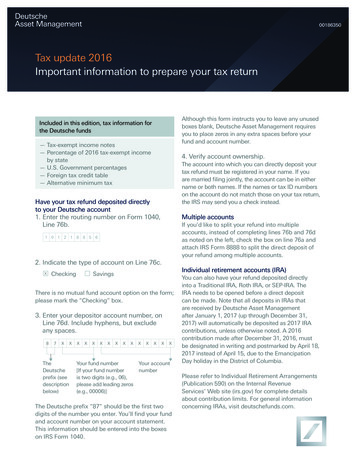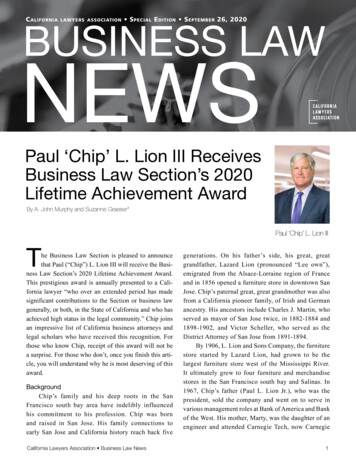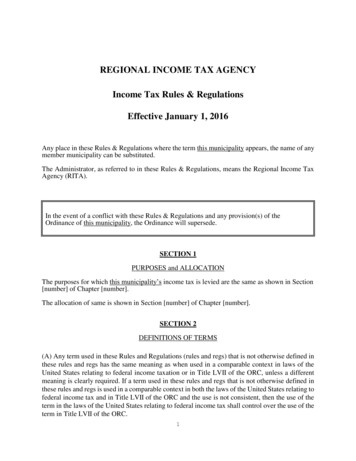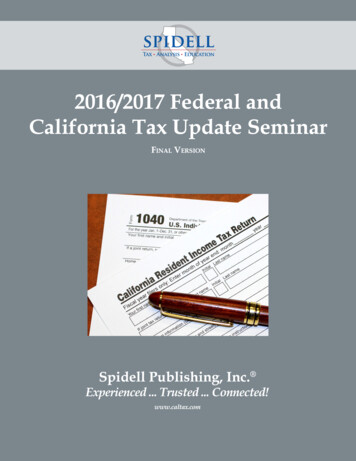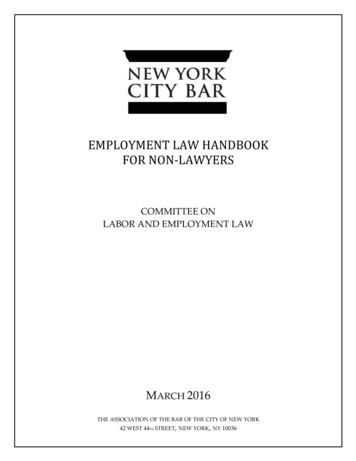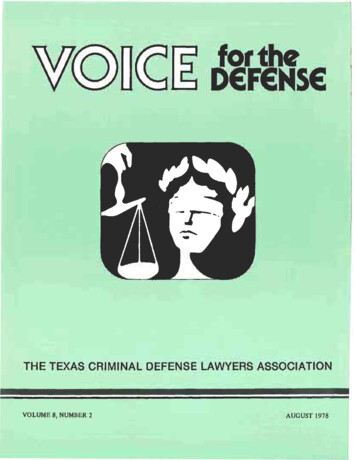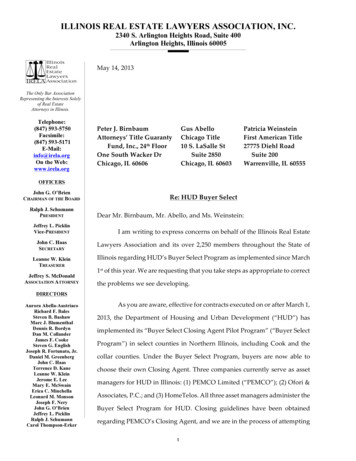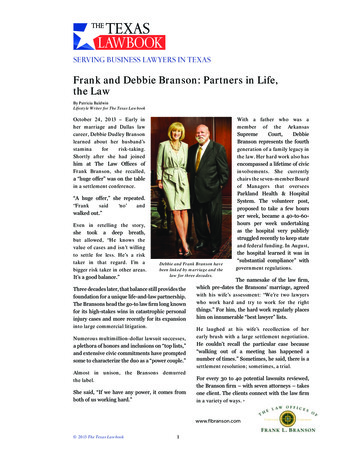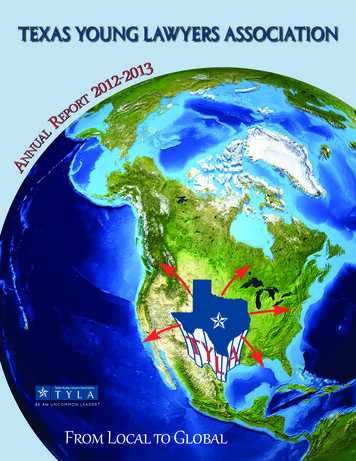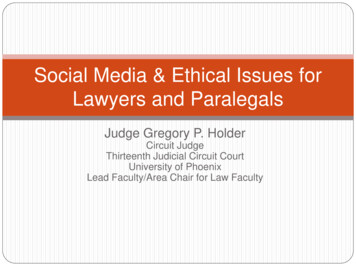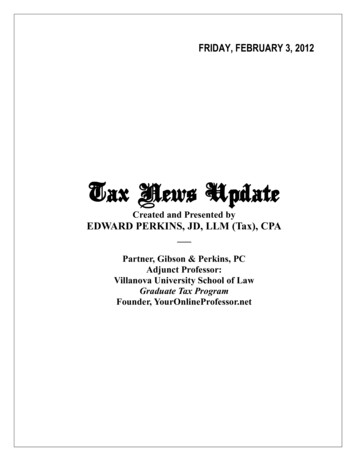
Transcription
FRIDAY, FEBRUARY 3, 2012Tax News UpdateCreated and Presented byEDWARD PERKINS, JD, LLM (Tax), CPAPartner, Gibson & Perkins, PCAdjunct Professor:Villanova University School of LawGraduate Tax ProgramFounder, YourOnlineProfessor.net
I.What’s New for 2011 Tax Returns?A.Individuals.1.The individual tax rates remain at 10, 15, 25, 28, 33, and 35 %.2.Basic standard deduction amounts have increased for 2011.3.The deduction for each personal exemption is 3,700 for 2011.4.Inflation-adjusted income amounts that trigger the reduction of allowableitemized deductions and personal exemptions for high-income taxpayers are repealed for2011.5.“Kiddie tax” amount is 1,900 for 2011.6.The standard mileage rate for all business use of a car is 51 cents per mile forJanuary 1 through June 30, 2011, and 55.5 cents per mile for July 1 through December 31,2011.7.Per diem rates under the high-low method of substantiating travel expensesare 242 for high-cost localities and 163 for low-cost localities for travel after 9/30/11.8.Student loan interest, up to 2,500 in 2011, may be deducted “above-the-lineby qualifying taxpayers.9.The transportation fringe benefit exclusion amount for employer providedparking and employer-provided transit passes or vehicles is 230 per month for 2011.10. The maximum Code Sec. 179 deduction for 2011 is 500,000; ceiling 2,000,000.B.Tax Credits.1.For 2011, the maximum earned income credit for eligible taxpayers with noqualifying children is 464, with one qualifying child is 3,094, with two qualifying children is 5,112, and with three or more qualifying children is 5,7512.The child tax credit is 1,000 for 20113.The education tax credits (American Opportunity (modified Hope) and lifetimelearning) are 2,500 and 2,000, respectively, for 20111
C.Withholding.1. 106,800.2.The 2011 OASDI wage base for FICA and self-employment tax purposes isThe 2011 wage threshold for “Nanny Tax” reporting is 1,700.II.What’s Changed for 2012?A.Provisions That Expired on 12/31/111.Green Provisions.a.Environmental Remediation Costs - The Election to expenseenvironmental remediation costs under Code Sec. 198(h) .b.Sec. 40A Biodiesel and Renewable Income Tax Credit - tax credits forbiodiesel and renewable diesel under Code Sec. 40A.c.Alternative Fuel and Fuel mixture tax credits - Alternative fuel and fuelmixture tax credits under Code Sec. 6426(d)(5) and Code Sec. 6426(e)(3) .d.New Energy Efficient Homes Tax Credit - Credit for construction ofnew energy efficient homes under Code Sec. 45L .e.Energy Efficient Appliance Tax Credit - Energy efficient appliancecredit under Code Sec. 45M).f.Residential Energy Property Credit – Under Code Sec. 25C expires.g.Mine Rescue Training Credit – the 20 percent credit for training rescueteam employees.2.ResearchSec. 41(h)(1)(B) Research Tax Credit - The Research credit under Code Sec.41(h)(1)(B) .3.Charitable Provisions.a.Food Inventory Deduction - Enhanced charitable deduction forcontributions of food inventory under Code Sec. 170(e)(3)(C).2
b.Book Inventory Deduction - Enhanced charitable deduction forcontributions of book inventories to public schools under Code Sec. 170(e)(3)(D)c.Computer Contributions - Enhanced deduction for corporatecontributions of computer equipment for educational purposes under Code Sec.170(e)(6)(G) .d.S Corporations - Lower shareholder basis adjustments for charitablecontributions by S corporations under Code Sec. 1367(a).e.Capital Gain Real Property - Special rules to encourage contributionsof capital gain real property for conservation purposes under Code Sec. 170(b)(1)(E)and Code Sec. 170(b)(2)(B).4.Empowerment Zonesa.Overview.Empowerment Zone tax breaks under Code Sec. 1391, Code Sec. 1394,Code Sec. 1396, Code Sec. 179, and Code Sec. 1397B .b.District Columbia.District of Columbia Enterprise Zone (DC Zone) tax breaks under Code Sec.1400(f), Code Sec. 1400A(b), and Code Sec. 1400B(b)(2)(A)(i)c.Puerto Rico.The inclusion of Puerto Rico as “within the U.S.” for purposes of determininga taxpayer's domestic production gross receipts (DPGR) under Code Sec.199(d)(8)(C) .5.Reduced Built In Gain Recognition Period.Reduced S corporation recognition period for built-in gains tax under Code Sec.1374(d)(7) .6.Small Business Stock Exclusion.Exclusion of 100% of gain on certain small business stock under Code Sec.1202(a)(4)3
7.Individual Provisionsa.Allowance of personal tax credits against regular tax and AMT underCode Sec. 26(a)(2)b.Tax-free distributions (up to 100,000 annually for taxpayers 70- 1/2and older) from individual retirement plans for charitable purposes under Code Sec.408(d)(8) .c.The deduction for mortgage insurance premiums for qualifiedmortgage insurance in connection with acquisition indebtedness.d.The provisions that enhanced the adoption credit to 13,170, andmade it refundable for 2011 are not extended. The adoption credit in 2012, adjustedfor inflation will be 12,650.e.The deduction for state and local sales tax in lieu of state and localincome tax not extended through December 31, 2011.f.Above-the-line for qualified tuition and related expenses is notextended after December 31, 2011.g.The 250 above –the-line deduction for teachers and oter schollprofessionals.8.Who Cares?a.The exclusion from a tax-exempt organization's unrelated businesstaxable income (UBTI) of interest, rent, royalties, and annuities paid to it from acontrolled entity under Code Sec. 512(b)(13)(E)(iv)b.Exception under subpart F for certain income from the active conductof a banking or similar business under Code Sec. 953(e)(10) and Code Sec.954(h)(9)c.Look-through treatment for payments between related controlledforeign corporations (CFCs) under the foreign personal holding company rules underCode Sec. 954(c)(6)B.Tax Rates, etc4
1.This year’s income tax brackets are a bit wider than those for 2011, becauseof an increase in inflation during the 12-month period ending last August that’s used tofigure the adjustments.2.The income tax rates for this year didn’t change because the Bush tax cutswere extended through 2012.3.The standard deductions for 2012 also increase by small amounts.a.Married couples can claim 11,900.b.If one spouse is age 65 or older 13,050.c.If both are 14,200. Singles can take 5,950. Those 65 and up candeduct 7,400.d.Heads of households can get 8,700 plus 1,450 more once theyreach age 65.e.spouse).Blind people get 1,150 more ( 1,450 if unmarried and not a survivingf.Personal exemptions increase to 3,800 for filers and theirdependents.4.D.High-incomers don’t lose any itemized deductions and personal exemptions.Changes for Tax Preparation Industry1.Expiring PTINs.PTINs issued after Sept. 27, 2010 and before Oct. 16, 2011 expired on Dec. 31,2011 and must be renewed. PTINs valid in 2011 can still be renewed at:http://www.irs.gov/taxpros/article/0,,id 210909,00.html?banner PTIN.2.E-file Mandate.a.Beginning in 2012, tax return preparers who expect to file 11 or moreindividual, estate, or trust returns in a calendar year must e-file. (Rev Proc 2011-25,2011-17 IRB)5
b.If the tax return preparer is a member of a firm, then in the aggregate ifthe firm expects to file more than 10 individual income tax returns then the tax returnpreparer is a specified tax return preparerc.An individual income tax return is one that is filed by an individual,estate or trust ( 1040 series - 1041 series - 990-T when the exempt organization is atrust subject to tax under section 511(b)).d.Does not apply if the taxpayer, by way of a hand-signed statement,informs the tax return preparer that the taxpayer, not the preparer, will file the paperreturn with the IRS.e.A specified tax return preparer can be waived from this requirementdue to undue hardship by filing the proper forms with the IRS for considerationf.Form 8944, Preparer e-file Hardship Waiver Request must be filedprior to the time a specified tax return preparer or the firm files an individual taxreturn for the calendar year; generally must be submitted between October 1, of thetaxable year and February 15, of the filing yearg.Lack of computer or software equipment or lack of desire to obtainsuch equipment alone will not constitute an undue hardshiph.exceptions3.Other exceptions may be set forth by the IRS as administrativeContinuing Education (CE) Requirements Apply.a.Starting in 2012, registered tax return preparers must complete 15hours of CE each year: 10 hours of federal tax law topics, three hours of tax lawupdates, and two hours of ethics and/or professional conduct.http://www.irs.gov/taxpros/article/0,,id 239684,00.htmlb.Anyone who is required to take the Registered Tax Return Preparercompetency exam must take Continuing Education creditsc.Attorneys and certified public accountants do not have to takecontinuing education credits6
d.Only credits offered by an IRS approved provider will count toward thecontinuing education credits required by the IRSe.4.Required records must be retained for four yearsEarned Income Credita.Heightened due diligence requirements for earned income tax credit(EITC) claims.b.For tax years ending on or after Dec. 31, 2011, paid tax returnpreparers must file a due diligence checklist (Form 8867) with any refund claim orfederal tax return claiming the EITC. (Reg. § 1.6695-2)5.New Form 2848 Power of Attorneya.Requires the representative to disclose their License/Bar or EnrollmentNumber on the signature lineb.A Form 2848 has to be filed for each individual; Representatives of aHusband and Wife who file jointly must file a 2848 for each individualE.Federal Payroll Tax Changes for 20121.Payroll Tax Cuta.The Temporary Payroll Tax Cut Continuation Act of 2011.(1)The Temporary Payroll Tax Cut Continuation Act of 2011 wasenacted late last year.(2)It temporarily extends the two percentage point payroll tax cutfor employees, continuing the reduction of their Social Security taxwithholding rate from 6.2% to 4.2% of wages paid through Feb. 29, 2012.(3)Shortly after its passage, the IRS instructed employers toimplement the new payroll tax rate as soon as possible in 2012 but not laterthan Jan. 31, 2012.b.Recapture7
(1)The law also includes a “recapture” provision, which appliesonly to those employees who receive more than 18,350 in wages during thetwo-month period (i.e., two-twelfths of the 2012 wage base of 110,100).(2)This provision imposes an additional income tax on thesehigher-income employees in an amount equal to 2% of the amount of wagesthey receive during the two-month period in excess of 18,350 (and notgreater than 110,100).c.Self-EmployedIn addition, under the new law, the social security tax rate for a self-employedindividual remains at 10.4%, for self-employment income of up to 18,350 (reducedby wages subject to the lower rate for 2012).d.Tax Year 2012Congress is going to try to negotiate a deal to extend the payroll tax cut for allof 2012. If a deal is struck to extend it for the full year, the recapture provision foremployees would not apply.2.W-2s.Employers may now submit up to 50 W-2 forms through W-2 Online (previously, upto 20 W-2 forms).3.Unemployment Tax.a.30, 2011.The 0.2% federal unemployment tax (FUTA) surtax expired on Juneb.The FUTA tax rate, before consideration of state unemployment taxcredits, is 6.2% from Jan. 1, 2011 to June 30, 2011, and 6.0% after June 30, 2011.c.Employers in 20 states (and in the Virgin Islands) will see their stateunemployment tax credits reduced on their 2011 FUTA return because their statefailed to repay its federal unemployment insurance loans before the requireddeadline.F.Business Changes8
1.Estimated taxes for large corporations.a.For a corporation with assets of at least 1,000,000,000 (determinedas of the end of the previous tax year), the amount of any required installment ofcorporate estimated tax which is otherwise due in July, Aug. or Sept. of 2012 is100.5% of that amount, andb.The amount of the next required installment after the installment due inJuly, Aug. or Sept. of 2012 is appropriately reduced to reflect the amount of the 0.5%increase. (P.L. 112-43, Sec. 502, P.L. 112-41, Sec. 505)2.Work Opportunity Credita.Work Opportunity Credit –(1)Available for businesses and tax-exempt organizations that hirequalified veterans that do not start work after December 31, 2012(2)Businesses claim the credit as part of the general businesscredit pursuant to I.R.C. sectionb.Credit amounts:(1)Up to 4,800 credit (credit is equal to 40% of “qualified wages”not to exceed 12,000) for a “qualified veteran” under section 51(d)(3)(A)(ii)(I)(2)Disabled veteran who is hired not more than 1 year afterdischarge or release from active duty(3)Up to 5,600 credit (credit is equal to 40% of “qualified wages”not to exceed 14,000) for a “qualified veteran” under section 51(d)(3)(A)(iv)(4)Veteran who, during the 1 year prior to the hiring date, hasaggregate periods of unemployment equal to or more than 6 months(5)Up to 9,600 credit (credit is equal to 40% of “qualified wages”not to exceed 24,000) for a “qualified veteran” under section51(d)(3)(A)(ii)(II)(6)Disabled veteran who, during the 1 year prior to the hiring date,has aggregate periods of unemployment equal to or more than 6 months9
c.ExpirationThe WOTC under Code Sec. 51 generally can't be claimed for an individualwho begins work for the employer after Dec. 31, 2011.d.However, the WOTC continues to be available for employers that hirequalified veterans who began work for the employer before Jan. 1, 2013.e.Credit for hiring veterans extended and enhanced.(1)Old LawA law enacted last November extended and enhanced a credit forhiring qualified veterans. Before the law was passed, the credit would havebeen available only if the qualified veteran were hired before Jan. 1, 2012,and only certain veterans were considered qualified veterans.(2)New LawThe new law (a) extends the credit for hiring qualified veterans, (b)adds two new classes of veterans who are considered qualified veterans, (c)increases the credit for hiring certain qualified veterans, (d) “fast-tracks” theprocess for certifying that an individual is a qualified veteran, and (e) providestax-exempt employers with a credit against payroll tax for hiring qualifiedveterans.3.Bonus Depreciationa.The Tax Relief Act increased the bonus for qualifying assets acquiredafter September 8, 2010, and place in service through December 31, 2011, from 50percent to 100 percent.b.The bonus rate for assets placed in service in 2012 is 50%; no bonusdepreciation after 2012.4.Code Sec. 1250 Expensing - Longer write-off Period for Certain Property.a.For specialized realty assets - qualified leasehold improvementproperty, qualified restaurant property, and qualified retail improvement property-10
placed in service in tax years 2010 and 2011, up to 250,000, have beenexpensable subject to Code Sec. 179 limitations.b.applies.5.After 2011, a 39-year (up from 15-year) writeoff period generallyReduced Sec. 179 Expensing.a.For a tax year beginning in 2012, the Code Sec. 179 expensingelection is reduced to 139,000, with a 560,000 investment-based ceiling (downfrom 500,000/ 2 million).b.For tax years beginning after 2012, it will be further reduced to 25,000 with a 200,000 investment-based ceiling.c.Additionally for a tax year beginning after 2011, expensing can nolonger be claimed for qualified real property.6.Who Cares - Basis reporting requirements.a.The complex stock basis and character reporting rules under CodeSec. 6045(g) apply to shares in a regulated investment company (RIC, i.e., a mutualfund), orb.Stock acquired in connection with a dividend reinvestment plan (DRP),if acquired after 2011.F.Individual Changes1.Reduced Alternative Minimum Tax (AMT) Exemption Amounts.a.Absent another AMT “patch,” the AMT exemption amounts for taxyears beginning after 2011 revert to the significantly lower “permanent” amounts of 33,750 for unmarried taxpayers, 45,000 for joint filers, and 22,500 for marriedsfiling separately.b.This is down from 47,450 for individuals and 72,450, for marriedsfiling jointly in 2010, and 48,750, and 74,470,respectively in 20112.No Parity for Exclusion from Income for Employer-provided mass transit andparking benefits.11
For 2012, unless Congress changes the rules, the exclusion for qualified parkingrises from 230 to 240 due to an inflation adjustment, but falls from 230 to 125 foremployer-provided transit and vanpooling benefits.G.Estate Law Changes1.The estate tax exemption for 2012 rises to 5,120,000, thanks to inflation.2.The rate stays at 35%.3.The annual gift tax exclusion remains at 13,000 per donee.4.The special estate tax valuation of real estate is increasing as well.5.valuation.Up to 1,040,000 of farm or business real estate can receive discount6.And more estate tax qualifies for an installment payment tax break. If aclosely held business or businesses make up more than 35% of an estate, as much as 486,500 of tax can be deferred, and IRS will charge only 2% interest.7.Rev Proc 2011-48 - Procedure for Filing/claiming a Protective Claim forRefund for Estate Tax.a.Protective claim for refund of estate tax based on a deduction undersection 2053:(1)For amounts that are not paid or otherwise deductible at thetime the Estate Tax Return (or GST Return) is filed, 20.2053-1(d)(5)(i) permitsthe filing of a protective claim for refund(2)May be filed in compliance with the time frame set forth in IRCsection 6511(a)b.Claim should be filed within 3 years from the time the return was filedor 2 years from the time the tax was paid (whichever is later); If no return was filedthen within 2 years from the time the tax was paidc.Claim must include the following:12
(1)identify the outstanding claim or expense that would have beendeductible under 2053(a) or (b) if it had been paid(2)payment(3)explain the reasons and contingencies delaying the actualstatement that it is under penalties of perjury(4)there must be a separate protective claim for each claim orexpense under section 2053d.A 2053 claim or expense will be deemed to include ancillary expensesrelated to resolving the claim (attorneys’ fees, court costs, appraisal fees, accountingfees); do not need to separate identify such expensese.Who can file:(1)Fiduciary or individual with legal authority claim must includedocumentary evidence (cert copies of letters testamentary, letters ofadministration, etc.) that establishes the legal authority(2)If individual is the same individual who filed the Tax Return thenonly a statement affirming that it is the same person and that the individual isstill acting in representative capacity on behalf of the estatef.Manner of filing claim:(1)If decedent died on or after January 1, 2012 a protective claimfor refund can be filed using a Schedule PC or Form 843(2)If decedent died after October 19, 2009 and before January 1,2012 must use a Form 843(3)Must notify Service within a reasonable time when thecontingency for payment has been resolved and the amount deductible hasbeen established(a)Reasonable time 90 days after the claim has beenpaid or after the amount becomes certain and is no longer subject to acontingency13
(b)Notification after the 90 day time frame should providesufficient explanation to establish reasonable cause for the delay(c)If there are multiple payments, the 90 day period startswith regard to the entire amount on the date of the last and finalpayment(4)Generally the Service will not engage in a substantive review ofthe claim until the amount has been established(5)Service will refund the overpaid estate tax on a timely filedprotective claim even if the claim or expense does not become deductibleunder section 2053 until after the 6511(a) filing deadlines have expiredH.Retirement Plan Limitations.1.401(k).The maximum amount that an employee may elect to defer to an Code Sec. 401(k)cash or deferred compensation plan is 17,000 in the 2012 tax year (up from 16,500 in2011).2.SEPsThe maximum amount th
Tax News Update Created and Presented by EDWARD PERKINS, JD, LLM (Tax), CPA _ Partner, Gibson & Perkins, PC Adjunct Professor: Villanova University School of Law Graduate Tax Program Founder, YourOnlineProfessor.net. 1 I. What’s New for 2011 Tax Returns? A. Individuals. 1. The individual t
